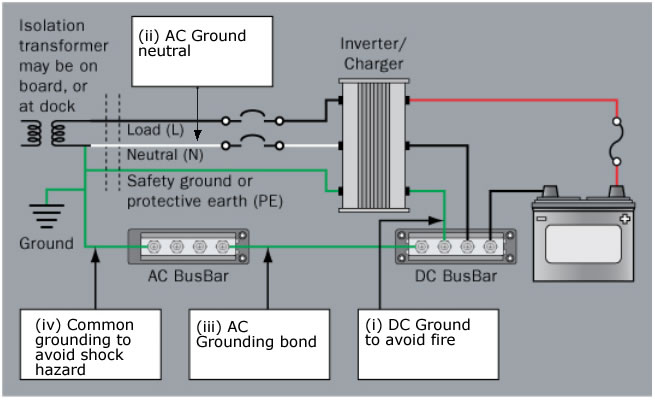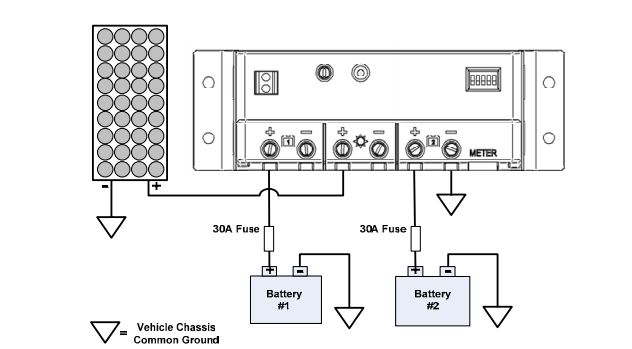
We often get questions on whether AC or DC electrical equipment should be grounded to the boat's or RV's bonding system. There are four separate ground systems: (i) DC ground, (ii) AC ground (neutral), (iii) AC grounding (or bond), and (iv) the boat's or RV's bonding system.
The Boat
The AC ground and grounding systems are "free floating," meaning that they do not ground on the vessel, but only to shore. The (ii) AC ground, or neutral, is a current carrying conductor, and could be the source of many troubles because it's not actually the grounding. The (iii) AC grounding, bond or green wire is the "safety" intended to channel current safely to ground in the event of a short circuit. Both of these circuits are capable of conducting current and can result in electrolysis on a boat when there are system faults with the dock or marina wiring.
The battery is the only point where the (i) DC side is grounded. It is also a "free floating" system in which nothing is ever grounded to any metallic part of the vessel, especially not the bonding system. Just like a car sitting on rubber tires, completely insulated from earth potential, the battery itself provides the negative potential.
The (iv) bonding system, also green wire, has nothing to do with electrical systems. Underwater metals are simply wired together to equalize differences in potential of different kinds of metal. Nothing should ever be grounded to the bonding system. The (iii) bonding system -or the common grounding system- may be a bus bar with a strip with screws or clamps. It may be a grounding wire running from the bow or the stern, hidden somewhere behind a panel and it will connect to (iv) the vessel's bonding system which could be the keel or a metal strip on the hull. Your boat's manual will provide the location.


The RV
Grounding of an RV and a boat are almost the same. The only difference is on the (i) DC ground where the negative DC wires could be directly connected to the chasis of the vehicle rather than connecting via a wire. In this case, the common grounding wire is the chassis.
I hope this was a helpful overview. Please remind yourself that the grounding could be very hazardous both on AC and DC side. Unless you are absolutely certain of what you are doing, consult to an electrician when wiring your electrical system.

Here are some resources I've used for putting this article together:
- Tips on Electrical System Use and Maintenance - David H. Pascoe
- Understanding Boat Wiring - John C. Payne
- Principles of Electrical Grounding (pdf) - John C. Pfeiffer
- Marine Grounding Systems - Stan Honey
- Grounding and Circuit Protection for Inverters and Battery Charges - Blue Sea Systems
- Sun Saver Duo Charge Controller Installation Manual (pdf) - Morningstar
- Marine lightning protection - commercial
Be sure to visit our storage homepage for more information.
Comments
I just read this article
AC Ground
See Practical Sailor, August 15, 1995 for a detailed treatment of the green wire. The best solution is a
heavy and expensive isolation transformer. The acceptable solution (for the rest of us) is to install a
light and inexpensive Galvanic Isolator in the green wire, between the shorepower cord socket on your
boat, and the connection to the boat's AC panel. Then, connect the grounding conductor (green) of
the AC panel directly to the engine negative terminal or its bus.